Related Research Articles
Syngas, or synthesis gas, is a mixture of hydrogen and carbon monoxide, in various ratios. The gas often contains some carbon dioxide and methane. It is principally used for producing ammonia or methanol. Syngas is combustible and can be used as a fuel. Historically, it has been used as a replacement for gasoline, when gasoline supply has been limited; for example, wood gas was used to power cars in Europe during WWII.
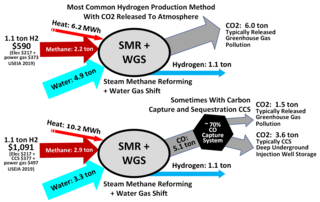
Steam reforming or steam methane reforming (SMR) is a method for producing syngas (hydrogen and carbon monoxide) by reaction of hydrocarbons with water. Commonly natural gas is the feedstock. The main purpose of this technology is hydrogen production. The reaction is represented by this equilibrium:
In industrial chemistry, coal gasification is the process of producing syngas—a mixture consisting primarily of carbon monoxide (CO), hydrogen, carbon dioxide, methane, and water vapour —from coal and water, air and/or oxygen.
Acid gas is a particular typology of natural gas or any other gas mixture containing significant quantities of hydrogen sulfide (H2S), carbon dioxide (CO2), or similar acidic gases. A gas is determined to be acidic or not after it is mixed with water. The pH scale ranges from 0 to 14, anything above 7 is basic while anything below 7 is acidic. Water has a neutral pH of 7 so once a gas is mixed with water, if the resulting mixture has a pH of less than 7 that means it is an acidic gas.
Sour gas is natural gas or any other gas containing significant amounts of hydrogen sulfide (H2S).
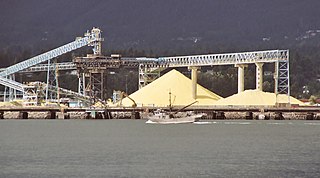
The Claus process is the most significant gas desulfurizing process, recovering elemental sulfur from gaseous hydrogen sulfide. First patented in 1883 by the chemist Carl Friedrich Claus, the Claus process has become the industry standard.
Amine gas treating, also known as amine scrubbing, gas sweetening and acid gas removal, refers to a group of processes that use aqueous solutions of various alkylamines (commonly referred to simply as amines) to remove hydrogen sulfide (H2S) and carbon dioxide (CO2) from gases. It is a common unit process used in refineries, and is also used in petrochemical plants, natural gas processing plants and other industries.
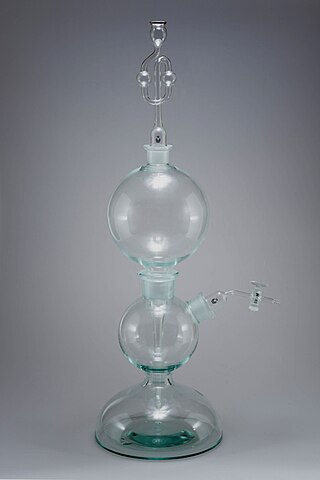
Kipp's apparatus, also called a Kipp generator, is an apparatus designed for preparation of small volumes of gases. It was invented around 1844 by the Dutch pharmacist Petrus Jacobus Kipp and widely used in chemical laboratories and for demonstrations in schools into the second half of the 20th century.

Hydrodesulfurization (HDS), also called hydrotreatment or hydrotreating, is a catalytic chemical process widely used to remove sulfur (S) from natural gas and from refined petroleum products, such as gasoline or petrol, jet fuel, kerosene, diesel fuel, and fuel oils. The purpose of removing the sulfur, and creating products such as ultra-low-sulfur diesel, is to reduce the sulfur dioxide emissions that result from using those fuels in automotive vehicles, aircraft, railroad locomotives, ships, gas or oil burning power plants, residential and industrial furnaces, and other forms of fuel combustion.
Water gas is a kind of fuel gas, a mixture of carbon monoxide and hydrogen. It is produced by "alternately hot blowing a fuel layer [coke] with air and gasifying it with steam". The caloric yield of this is about 10% of a modern syngas plant. Further making this technology unattractive, its precursor coke is expensive, whereas syngas uses cheaper precursor, mainly methane from natural gas.
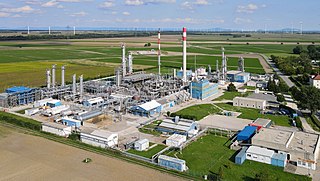
Natural-gas processing is a range of industrial processes designed to purify raw natural gas by removing contaminants such as solids, water, carbon dioxide (CO2), hydrogen sulfide (H2S), mercury and higher molecular mass hydrocarbons (condensate) to produce pipeline quality dry natural gas for pipeline distribution and final use. Some of the substances which contaminate natural gas have economic value and are further processed or sold. Hydrocarbons that are liquid at ambient conditions: temperature and pressure (i.e., pentane and heavier) are called natural-gas condensate (sometimes also called natural gasoline or simply condensate).
Selexol is the trade name for an acid gas removal solvent that can separate acid gases such as hydrogen sulfide and carbon dioxide from feed gas streams such as synthesis gas produced by gasification of coal, coke, or heavy hydrocarbon oils. By doing so, the feed gas is made more suitable for combustion and/or further processing. It is made up of dimethyl ethers of polyethylene glycol.
A biogas upgrader is a facility that is used to concentrate the methane in biogas to natural gas standards. The system removes carbon dioxide, hydrogen sulphide, water and contaminants from the biogas. One technique for doing this uses amine gas treating. This purified biogas is also called biomethane. It can be used interchangeably with natural gas.
The wet sulfuric acid process (WSA process) is a gas desulfurization process. After Danish company Haldor Topsoe introduced this technology in 1987, it has been recognized as a process for recovering sulfur from various process gases in the form of commercial quality sulfuric acid (H2SO4) with the simultaneous production of high-pressure steam. The WSA process can be applied in all industries where sulfur removal presents an issue.
CrystaSulf is the trade name for a chemical process used for removing hydrogen sulfide (H2S) from natural gas, synthesis gas and other gas streams in refineries and chemical plants. CrystaSulf uses a modified liquid-phase Claus reaction to convert the hydrogen sulfide (H2S) into elemental sulfur which is then removed from the process by filtration. CrystaSulf is used in the energy industry as a mid-range process to handle sulfur amounts between 0.1 and 20 tons per day. Below 0.1 tons of sulfur per day is typically managed by H2S Scavengers and applications above 20 tons per day are typically treated with the Amine – Claus process.
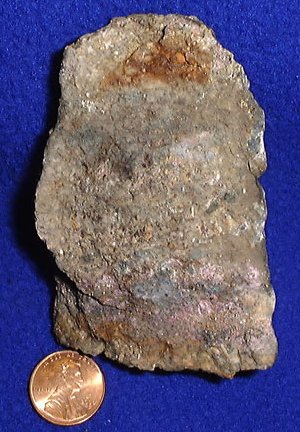
Cobalt extraction refers to the techniques used to extract cobalt from its ores and other compound ores. Several methods exist for the separation of cobalt from copper and nickel. They depend on the concentration of cobalt and the exact composition of the ore used.
The first time a catalyst was used in the industry was in 1746 by J. Roebuck in the manufacture of lead chamber sulfuric acid. Since then catalysts have been in use in a large portion of the chemical industry. In the start only pure components were used as catalysts, but after the year 1900 multicomponent catalysts were studied and are now commonly used in the industry.
Coal gasification is a process whereby a hydrocarbon feedstock (coal) is converted into gaseous components by applying heat under pressure in the presence of steam. Rather than burning, most of the carbon-containing feedstock is broken apart by chemical reactions that produce "syngas." Syngas is primarily hydrogen and carbon monoxide, but the exact composition can vary. In Integrated Gasification Combined Cycle (IGCC) systems, the syngas is cleaned and burned as fuel in a combustion turbine which then drives an electric generator. Exhaust heat from the combustion turbine is recovered and used to create steam for a steam turbine-generator. The use of these two types of turbines in combination is one reason why gasification-based power systems can achieve high power generation efficiencies. Currently, commercially available gasification-based systems can operate at around 40% efficiencies. Syngas, however, emits more greenhouse gases than natural gas, and almost twice as much carbon as a coal plant. Coal gasification is also water-intensive.
The Liquid Nitrogen Wash is mainly used for the production of ammonia synthesis gas within fertilizer production plants. It is usually the last purification step in the ammonia production process sequence upstream of the actual ammonia production.
Sorption enhanced water gas shift (SEWGS) is a technology that combines a pre-combustion carbon capture process with the water gas shift reaction (WGS) in order to produce a hydrogen rich stream from the syngas fed to the SEWGS reactor.
References
- ↑ Kohl, A & Nielsen, R. (1997). Gas Purification (Fifth ed.). Gulf Publishing Company.
- ↑ “Process Screening Analysis of Alternative Gas Treating and Sulfur Removal for Gasification” Revised Final Report; December 2002; Nick Korens, Dale R. Simbeck, Donald J. Wilhelm; SFA Pacific, Inc. Mountain View, California